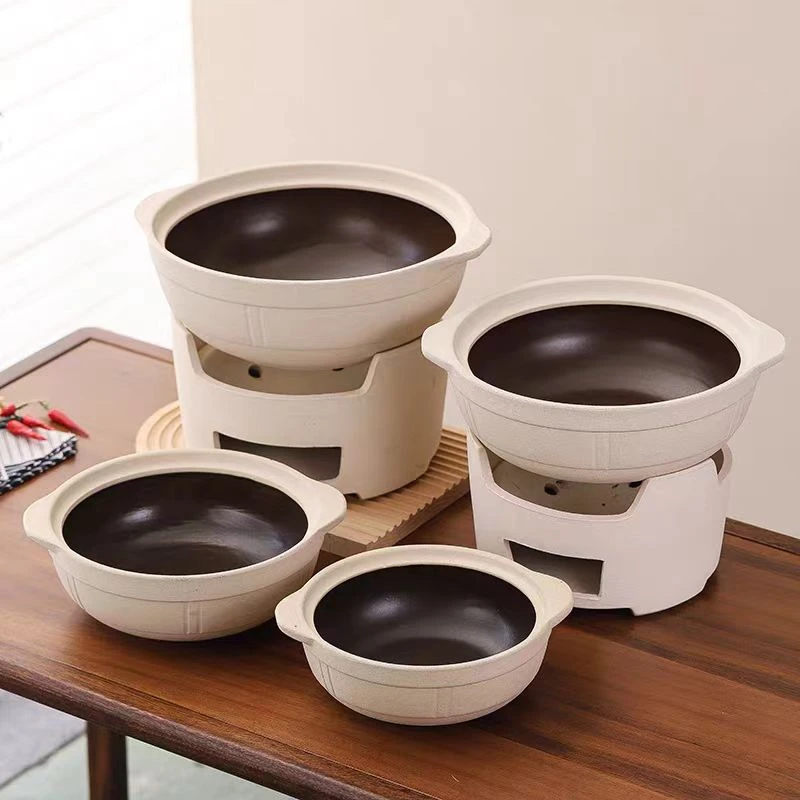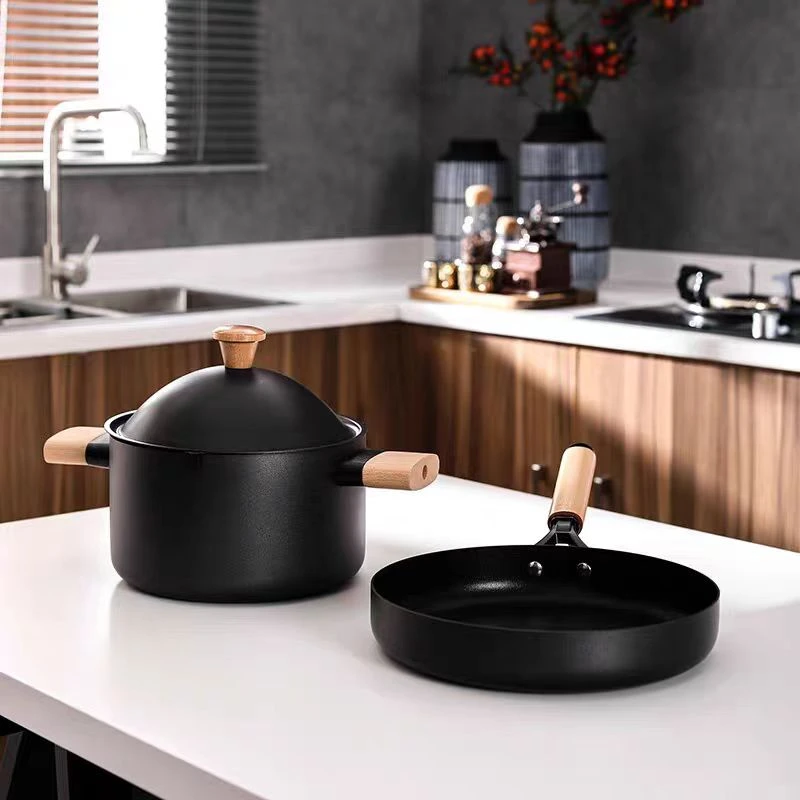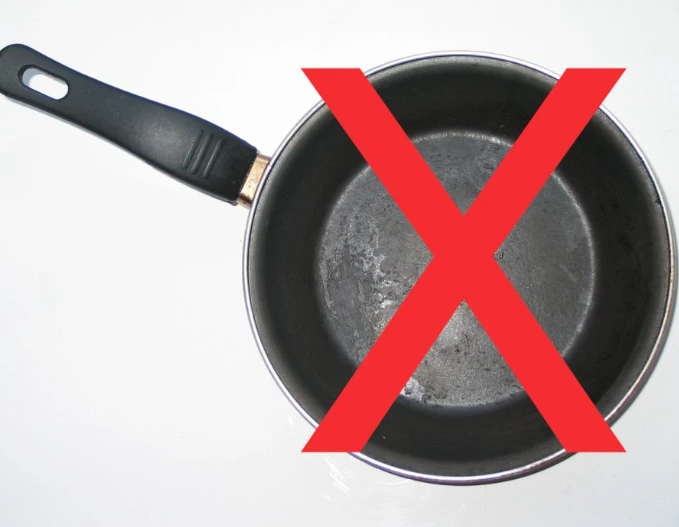في الطهي المنزلي، بالإضافة إلى اختيار المكونات عالية الجودة، فإن سلامة أواني الطهي تؤثر أيضًا بشكل مباشر على صحتنا. قد تطلق بعض أواني الطهي مواد ضارة في درجات الحرارة المرتفعة، وسيكون للاستخدام على المدى الطويل آثار ضارة على الجسم. إذًا، ما نوع أواني الطهي غير السامة حقًا 100%؟ كما شركة تصنيع أواني الطهي بالجملة، سأقوم بتحليل أواني الطهي الأربعة الأكثر أمانًا بالتفصيل لمساعدتك في إنشاء مطبخ صحي وغير سام.

مقارنة بين 4 أنواع من أواني الطهي غير السامة
| مواد أواني الطهي | سبب غير سام | الفوائد الصحية | العيوب |
| أواني طهي من السيراميك النقي | مصنوعة من مواد طبيعية، خالية من الطلاءات الكيميائية أو المواد الضارة مثل PTFE وPFOA والرصاص والكادميوم | لا تطلق مواد ضارة؛ مناسبة للطهي في درجات الحرارة العالية | باهظة الثمن وهشة وتتطلب التعامل معها بعناية |
| أواني طهي من الفولاذ المقاوم للصدأ | خالية من الطلاءات الكيميائية، ومقاومة عالية للتآكل، ولا تتفاعل مع الطعام | متين ومناسب للقلي والتشويح والطبخ على نار هادئة | قد يؤدي الفولاذ المقاوم للصدأ منخفض الجودة إلى ترشيح النيكل أو معادن أخرى؛ يوصى بالخيارات عالية الجودة |
| أواني الطهي المصنوعة من الحديد الزهر | خالي من الطلاءات الكيميائية؛ يطور سطحاً غير لاصق بشكل طبيعي | يضيف الحديد الغذائي، وهو مثالي للطهي في درجات الحرارة العالية | تتطلب صيانة دورية، عرضة للصدأ، وليست مثالية للطهي الحمضي لفترات طويلة |
| أواني طهي من الفولاذ الكربوني | يطور طبقة توابل طبيعية لسطح غير سام وغير لاصق وخالٍ من الطلاءات الكيميائية | خفيف الوزن، مثالي للطهي في درجات الحرارة العالية | تحتاج إلى صيانة لمنع الصدأ؛ تتطلب طبقة التتبيل تجديداً دورياً1 |

أواني الطبخ غير السامة 1: أواني الطبخ الخزفية النقية
تعتبر أواني الطهي المصنوعة من السيراميك النقي (غير المطلي بالسيراميك) من أكثر أواني الطهي أمانًا في السوق لأنها غير سامة تمامًا وصديقة للبيئة.
أسباب غير سامة
السيراميك النقي مصنوع بالكامل من المعادن الطبيعية ولا يحتوي على أي مواد كيميائية أو طلاءات صناعية. كما أنه خالٍ تماماً من المواد الضارة المحتملة مثل PTFE (بولي تترافلوروإيثيلين) و PFOA (حمض البيرفلوروكتانويك) والرصاص والكادميوم، لذلك لا يطلق غازات أو مواد كيميائية ضارة.
المزايا الصحية
يمكن لأواني الطهي المصنوعة من السيراميك النقي أن تحافظ على ثباتها في البيئات ذات درجات الحرارة العالية، مما يضمن عدم تسرب أي مواد ضارة أثناء الطهي. بالإضافة إلى ذلك، تتمتع مواد السيراميك بخصائص ممتازة لحفظ الحرارة، ويمكنها توزيع الحرارة بالتساوي وتقليل الضرر الذي يلحق بالتغذية بسبب ارتفاع درجة الحرارة الموضعي.
العيوب
الهشاشة: السيراميك عرضة للكسر عند مواجهة أجسام صلبة أو تغيرات جذرية في درجات الحرارة المرتفعة والمنخفضة، لذلك يجب استخدامه وتخزينه بعناية أكبر.
الوزن الثقيل: قد تكون بعض المنتجات الخزفية النقية ثقيلة وغير مناسبة لطرق الطهي التي تتطلب القلي المتكرر.
سيناريوهات قابلة للتطبيق
إنه مناسب جدًا للحساء أو اليخنات أو الطهي البطيء في درجات حرارة منخفضة، مما يحافظ على النكهة الأصلية للطعام إلى أقصى حد.

أواني الطهي غير السامة 2: أواني الطهي المصنوعة من الفولاذ المقاوم للصدأ
أسباب غير سامة
أواني طهي من الفولاذ المقاوم للصدأ لا يحتوي على طلاء كيميائي وهو مقاوم للغاية للتآكل. لا يطلق الفولاذ المقاوم للصدأ عالي الجودة أيونات معدنية ضارة، خاصة في ظروف الطهي العادية.
المزايا الصحية
تعدد الاستخدامات: مناسب لمجموعة متنوعة من طرق الطهي، مثل القلي والقلي السريع والطبخ بالبخار والغلي.
سهلة التنظيف: سطح الفولاذ المقاوم للصدأ أملس، وليس من السهل التصاق بقايا الطعام به، وسهل التنظيف بعد الاستخدام.
متانة عالية: يتميز الفولاذ المقاوم للصدأ بمقاومة جيدة للخدش ويمكنه تحمل درجات الحرارة العالية والاستخدام عالي الكثافة.
العيوب
محتوى النيكل والكروم: قد يحتوي الفولاذ المقاوم للصدأ منخفض الجودة على مكونات النيكل أو الكروم الأعلى جودة، والتي قد تنطلق بكميات صغيرة عند طهي الأطعمة الحمضية، وقد يؤثر الاستخدام طويل الأمد على الأشخاص الحساسين. ولذلك، يجب اختيار منتجات الفولاذ المقاوم للصدأ التي تحمل علامة وشهادة الجودة الغذائية.
التوصيل الحراري العام: يتميز الفولاذ المقاوم للصدأ في حد ذاته بضعف التوصيل الحراري، وعادةً ما يتطلب إضافة طبقات بينية من الألومنيوم أو النحاس لتحسين التوصيل الحراري.
سيناريوهات قابلة للتطبيق
أواني الطهي المصنوعة من الفولاذ المقاوم للصدأ مناسبة للقلي اليومي والقلي السريع والطبخ ومناسبة أيضًا لبيئات مثل مطابخ المطاعم التي تتطلب المتانة والكفاءة.

أواني الطهي غير السامة 3: أواني الطهي المصنوعة من الحديد الزهر
تُعد أواني الطهي المصنوعة من الحديد الزهر خياراً كلاسيكياً في عالم الطهي بسبب متانتها الممتازة وخصائصها الطبيعية غير السامة.
لماذا هي غير سامة?
لا تحتوي أواني الطهي المصنوعة من الحديد الزهر على أي طلاءات كيميائية، وتتشكل طبقة واقية بشكل طبيعي أثناء الاستخدام لمنع التلامس المباشر بين الحديد والطعام. بالإضافة إلى ذلك، تساعد هذه الطبقة الواقية الطبيعية أيضًا على منع التصاق الطعام بالمقلاة.
المزايا الصحية
مكمل الحديد: قد يتم إطلاق كميات صغيرة من الحديد أثناء الطهي، خاصةً عند الطهي، وهو مكمل صحي إضافي لبعض الأشخاص الذين يعانون من نقص الحديد.
مقاومة درجات الحرارة العالية: يمكن أن تتحمل مقالي الحديد الزهر درجات حرارة عالية للغاية، مما يجعلها مثالية للقلي والطبخ والخبز.
حرارة متساوية: تتميز أواني الطهي المصنوعة من الحديد الزهر باحتفاظها القوي بالحرارة وقدرتها على توزيع الحرارة بالتساوي، مما يجعلها مناسبة للوصفات التي تتطلب طهيًا بطيئًا.
العيوب
الوزن الثقيل: عادة ما تكون المقالي المصنوعة من الحديد الزهر كبيرة الحجم وغير مناسبة للقلي السريع.
الصيانة مطلوبة: تكون المقالي المصنوعة من الحديد الزهر عرضة للصدأ أو فقدان خصائصها الطبيعية المانعة للالتصاق إذا لم تتم صيانتها بشكل صحيح.
غير مناسب للأطعمة الحمضية: قد يؤدي طهي الأطعمة الحمضية لفترة طويلة إلى تلف الطبقة الواقية وحتى التسبب في إطلاق الحديد بشكل مفرط.
سيناريوهات قابلة للتطبيق
أواني الطهي المصنوعة من الحديد الزهر مناسبة للطبخ والخبز والطبخ في الهواء الطلق، وهي مناسبة جدًا للأطباق التي تتطلب وقتًا طويلاً للطهي.

أواني الطهي غير السامة 4: أواني الطهي المصنوعة من الفولاذ الكربوني
أصبحت أواني الطهي المصنوعة من الفولاذ الكربوني خيارًا صحيًا شائعًا بشكل متزايد بفضل وزنها الخفيف وخصائصها المشابهة للحديد الزهر.
أسباب غير سامة
توفر أواني الطهي المصنوعة من الفولاذ الكربوني خصائص مانعة للالتصاق من خلال طبقة توابل متكونة بشكل طبيعي، مستقلة تمامًا عن أي طلاء كيميائي.
المزايا الصحية
ثبات في درجات الحرارة العالية: مناسبة للقلي والقلي على درجة حرارة عالية دون القلق بشأن إطلاق مواد ضارة.
خفيف الوزن: أخف من الحديد الزهر وأخف وزناً من الحديد الزهر وسهل القلي والتحريك.
تسخين سريع: يسخن الفولاذ الكربوني بسرعة، وهو مناسب لأطباق القلي السريع.
العيوب
عرضة للصدأ: الفولاذ الكربوني عرضة للأكسدة إذا لم يتم تنظيفه في الوقت المناسب أو تخزينه بشكل صحيح.
تحتاج طبقة التتبيل إلى صيانة: قد تبلى طبقة التتبيل بمرور الوقت وتحتاج إلى إعادة التتبيل بانتظام للحفاظ على الأداء.
سيناريوهات قابلة للتطبيق
تُعد أواني الطهي المصنوعة من الفولاذ الكربوني رائعة للقلي الصيني والقلي السريع والشواء في الهواء الطلق، خاصة للطهاة الذين يحبون الطهي على درجات حرارة عالية.

نصائح لاختيار أواني الطهي الصحية
اختر أواني الطهي غير السامة الأنسب وفقًا لاحتياجات الطهي المختلفة والميزانية:
- يمكن للمستخدمين الذين يفضلون الطهي البطيء أو الطهي على درجة حرارة عالية اختيار الحديد الزهر أو السيراميك النقي;
- يوصى باستخدام الفولاذ المقاوم للصدأ عالي الجودة لأواني الطهي اليومية متعددة الأغراض;
- أما الطهاة الذين يفضلون الخفة والقلي على درجة حرارة عالية فيمكنهم تجربة الفولاذ الكربوني;
- يمكن للعائلات التي تفضل الأكل الصحي والطبخ قليل الزيت أن تختار أواني الطهي المطلية بالسيراميك.
ما هي مواد أواني الطهي التي يجب تجنبها؟
أواني طهي تقليدية غير لاصقة: قد تطلق المقالي المانعة للالتصاق التي تستخدم مادة PTFE (تفلون) أو PFOA غازات ضارة في درجات الحرارة العالية.
أواني طهي الألمنيوم الرخيصة قد تنضح مقالي الألومنيوم غير المؤكسدة بالمعدن أثناء الطهي، خاصة مع الأطعمة الحمضية.
أواني طهي بالمينا رديئة الجودة: يمكن أن تتساقط طبقات المينا منخفضة الجودة بسهولة، مما يعرض المعادن التي يحتمل أن تكون ضارة.

كيف تختار أدوات المطبخ غير السامة 100%؟
- انتبه للشهادة: أعط الأولوية للمنتجات التي اجتازت شهادة المواد الكيميائية غير الضارة، مثل تلك التي تحمل علامة "PTFE، خالية من مادة PFOA".
- اختر العلامات التجارية المعروفة: عادةً ما ترتبط سمعة العلامة التجارية بجودة المنتج وتستحق الاستثمار فيها.
- مناسب للاستخدام: اختر المادة المناسبة وفقًا لاحتياجات الطهي الشخصية، مثل الفولاذ المقاوم للصدأ أو الحديد الزهر للقلي، وطلاء السيراميك للطهي قليل الزيت.
الملخص
تشتمل أدوات المطبخ غير السامة 100% من Truly 100% على السيراميك النقي والفولاذ المقاوم للصدأ والحديد الزهر والفولاذ الزنبركي وغيرها من المواد. لا تحتوي على أي مواد كيميائية ضارة ويمكن أن توفر لك ولعائلتك تجربة طهي صحية أكثر. من خلال اختيار أدوات المطبخ عالية الجودة والآمنة، يمكنك الاستمتاع بالطعام اللذيذ بأمان أكبر مع حماية صحة عائلتك.
